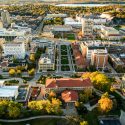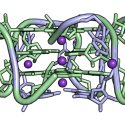UW–Madison increases research expenditures by $16 million, retains top 10 research institution ranking

The National Science Foundation has ranked UW–Madison eighth among the nation’s public and private universities in its 2021 fiscal year Higher Education Research and Development data. Photo: Althea Dotzour
The National Science Foundation has released its 2021 fiscal year Higher Education Research and Development (HERD) data, and the University of Wisconsin–Madison has again ranked eighth in the national research rankings for public and private universities. UW–Madison ranked eighth in the last survey covering the 2020 fiscal year. The rankings are the first to include a full fiscal year reflecting pandemic impacts.
Between July 2020 and the end of June 2021, the university increased its annual research expenditures over the previous year, reporting more than $1.38 billion in annual expenditures across all fields, about half of which comes from federal awards. It represents an increase of $16.1 million over fiscal year 2020.
“Today’s announcement is a testament to the hard work and innovation of our UW–Madison research community,” says UW–Madison Chancellor Jennifer L. Mnookin. “I am pleased we sustained and even slightly improved our research productivity during a period severely impacted by COVID-19, and I look forward to supporting, exploring and expanding research opportunities across all our divisions, to make our impressive research enterprise even stronger.”
The HERD survey is an annual census of institutions that spend at least $150,000 on separately budgeted research and development in a fiscal year and is the primary source of such expenditure data at American universities and colleges. It is one way to measure academic research activity.
The survey collects information on expenditures by research field and funding source. It also compiles information on types of research expenses and the number of research and development personnel. In fiscal year 2021, more than 909 universities responded to the survey.
“The HERD rankings are one way to measure our academic research activity at UW–Madison,” says Steve Ackerman, vice chancellor for research and graduate education. “Looking ahead, we will be intensifying our efforts to maximize our survey performance in future years. Though we value the HERD survey results and consider them important indicators of our success as a research institution, we also look to various other metrics to paint a fuller picture of our faculty, staff and student innovation achievements.”
Some of UW–Madison’s largest research expenditures in fiscal year 2021 include:
- $26.9M for the Great Lakes Bioenergy Research Center (Department of Energy)
- $11.2M for the Cooperative Institute for Meteorological Satellite Studies (National Oceanic and Atmospheric Administration)
- $10.4M for the multi-study, multi-center initiative Inner City Asthma Consortium (National Institutes of Health)
- $2.7M for the Wisconsin Materials Research Science and Engineering Center (National Science Foundation)
- $2.2M for the Dairy Farmers of Wisconsin/Center for Dairy Research Dairy Research Applications Program. (Dairy Farmers of Wisconsin)
While academic research funding at UW–Madison comes primarily from federal government and institutional support, state and local government, industry, nonprofit organizations and foundations also support the university. The two most significant non-profit contributors of research funding to UW–Madison are the Wisconsin Alumni Research Foundation and UW Foundation.
“We are grateful to WARF and UW Foundation for their continued investment in our research initiatives, including new cross-disciplinary campus research competitions to address some of society’s greatest challenges,” Ackerman says. “UW–Madison’s success is fueled by creative and analytical inquiry inspired by the Wisconsin Idea.”
For academic year 2022-2023, WARF announced a total of $130 million across all grant categories and programs for UW–Madison. The base grant, supporting research during the current fall and upcoming spring and summer semesters, is $66.1 million.
Fiscal year 2022 was also a banner year for grant getters at UW–Madison, in which extramural research and public service award dollars grew by $80 million, or 6%, compared to fiscal year 2021.
UW–Madison has also recently received other prestigious ratings that are leading indicators of its research and scholarly success:
- Last month, the Association of Public and Land-grant Universities designated UW–Madison an Innovation and Economic Prosperity (IEP) University, based on the university’s commitment to economic engagement, including its focus on innovation and entrepreneurship, technology transfer, talent and workforce development and public service and community engagement.
- Marcel Schreier, professor in chemical and biological engineering and affiliate faculty in chemistry, was one of 20 early-career scientists in the U.S. chosen in 2022 for a Packard Fellowship, becoming UW–Madison’s 18th
- Monica Kim, associate professor of history and a historian of the United States and international and diplomatic history, was recently awarded a 2022 MacArthur Fellowship.
- Three UW–Madison researchers were recently named Fellows with the National Academy of Inventors: Jo Handelsman, director of the Wisconsin Institute for Discovery and Vilas research professor; Susan Hagness, department chair of Electrical and Computer Engineering; and Justin Williams, professor of biomedical engineering.
Tags: milestones, research



